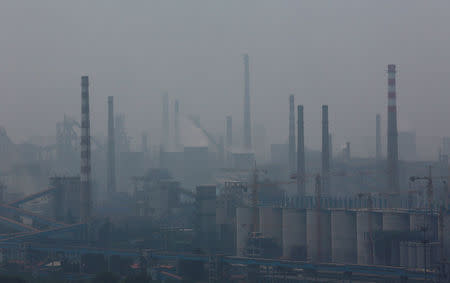China's wary lenders force rust-belt country to take expensive shadow bank loans
By Nathaniel Taplin SHANGHAI (Reuters) - Mainstream lenders in China are squeezing borrowers in the country's rust-belt provinces, forcing firms to take on higher interest-rate loans from so-called shadow banks, a Reuters analysis of central bank figures shows. In several of the hardest hit industrial provinces, including deeply troubled steel and coal producing regions, the swing back to the shadow sector – lenders outside conventional banking who usually charge much higher interest rates than traditional banks - has been stark. Firms in Liaoning, an industrial powerhouse in China's northeast, borrowed over 2,000 percent more from shadow banks in the first quarter of this year, compared with a year earlier. The borrowing accounted for 19 percent of the province's total financing, up from just 1 percent in the first quarter of 2015. "Economically advanced regions, especially those with strong access to municipal bond funding, don't really have to fall back on shadow financing as much," said a director at a Shanghai-based asset management firm. "Smaller and poorer areas are different." The sharp retreat of weaker regions into shadow lending - when credit as a whole has expanded massively - suggests that traditional creditors are rapidly abandoning the long-held belief that lending to state-owned enterprises (SOEs) is risk free because local governments nearly always bail them out. An increasing number of bond defaulters over the past half year have been state-owned firms, many in legacy industrial sectors. The change is in line with official efforts to shrink the country's industrial overcapacity, but could shift growing risks in the corporate bond market back onto the shoulders of retail investors buying wealth management products backed by shadow banking loans. Economists have long argued the government needs to ensure credit is delivered to more productive parts of the economy if it wants to sustain growth. For that to happen, lenders need to price in real credit risk. To an extent, that now appears to be happening. "It's no longer a case of who owns the thing, but in which industry they're in. So of course certain regions are more exposed and we look at that," said a Singapore-based fund manager who invests in Chinese debt. Central bank figures show that wealthier regions largely found credit easy to come by in the first quarter – when commercial bank lending rose to a record high. Among better-off regions, only Shanghai experienced a substantial increase in the share of non-bank lending as a proportion of overall loans in the first quarter. But firms in legacy industrial regions like Liaoning found themselves increasingly reliant on shadow bank finance. Net shadow bank lending in Hebei, Shanxi, Jilin, Anhui, Henan, Sichuan and Shandong rose 240 percent to 249 billion yuan in the first quarter, against a 30 percent rise nationwide. GETTING TOUGH Shadow banking rose to prominence in the boom years after the global financial crisis when Beijing encouraged a debt binge to help the economy bounce back from the downturn. Between 2011 and 2013, outstanding shadow bank credit jumped more than 50 percent to over 30 trillion yuan (£3.2 trillion), ratings agency Moody's said. Worried about the pace of growth, the government initiated a broad crackdown on shadow banking in 2014. That year, China also began to cautiously allow bond issuers to default, although many were subsequently bailed out. This year the climate is more severe. An unprecedented number of over 20 bond defaults have been confirmed as many companies, especially in industries with surplus production, feel the pinch of China's weakest economic growth in 25 years. China's policymakers have issued a series of tough comments on "zombie" SOEs, many of which are heavily indebted from years of breakneck expansion. Reflecting the changing attitude, corporate debt sold off sharply in April and credit spreads rose to their widest levels since 2012 as investors priced-in different risk for different debtors. "For the whole of April, the government's actions and messages on zombie SOEs were very in line and clear cut," said the Singapore-based fund manager. An April 20 central bank statement appears to have helped crystallize bond market scepticism. It urged financial institutions to support the "rational" financing needs of coal and steel firms but "resolutely compress and withdraw" loans for long-term money-losing firms that had "lost market competitiveness." In March, a banker at a mid-tier commercial bank in northern China told China Business News his bank had begun a two-pronged strategy of "controlling growth, reducing existing" credit towards coal and steel dependent regions, including Shanxi. And earlier this month, state-owned Shaanxi Coal and Chemical Industry Group Co Ltd became the latest coal firm to delay a planned bond issue, citing "highly volatile" market conditions. Lending by trust firms, key actors in the shadow banking market that package loans into investment products, rose in the first quarter to its highest level since June 2014. Research firm Puyi said new trust products created in the first quarter offered investors annual yields averaging 8-9 percent, highlighting the risks for struggling economies borrowing from the sector. In Liaoning, for example, the economy shrank 1 percent on the year in the first quarter. Perhaps aware of growing wariness about shadow bank lending, some trusts are using creative methods to get investors to part with their cash. In Tibet, where shadow bank lending rose 50 percent in 2015, trusts are offering leased BMWs as an inducement to invest in one- and three-year products. (Additional reporting by the Shanghai Newsroom; Editing by Neil Fullick)

 Yahoo Finance
Yahoo Finance 

